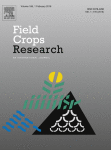View Item
- xmlui.general.dspace_homeCentros Regionales y EEAsCentro Regional Buenos Aires SurEEA BarrowArtículos científicosxmlui.ArtifactBrowser.ItemViewer.trail
- DSpace Home
- Centros Regionales y EEAs
- Centro Regional Buenos Aires Sur
- EEA Barrow
- Artículos científicos
- View Item
Maize prolificacy: a source of reproductive plasticity that contributes to yield stability when plant population varies in drought-prone environments
Abstract
Reproductive plasticity, the ability of the plant to maintain the ratio between available resources and grain yield should be a useful trait to maintain the coupling between yield and resource availability under low-density management strategies adopted in drought-prone areas. Prolificacy could be an indicator of hybrid reproductive plasticity. The objective of this study was to assess the reproductive plasticity of modern prolific and non-prolific
[ver mas...]
Reproductive plasticity, the ability of the plant to maintain the ratio between available resources and grain yield should be a useful trait to maintain the coupling between yield and resource availability under low-density management strategies adopted in drought-prone areas. Prolificacy could be an indicator of hybrid reproductive plasticity. The objective of this study was to assess the reproductive plasticity of modern prolific and non-prolific hybrids and its effect on grain yield and yield components in a drought-prone environment. Current hybrids of contrasting prolificacy were tested in shallow soil under different plant densities (2 to 6 pl m–2). Crops explored low productivity environments (average 5930 kg ha–1) and yield response to plant density was different between prolificacy groups. At 4 pl m–2 yield was similar between prolific and non-prolific hybrid groups. Prolificacy determined an increase in reproductive plasticity that significantly reduced the yield response to plant density. When plant density was reduced to 2 pl m–2 yield was maintained for the prolific hybrids while it was reduced more than 25% for the non-prolific ones. The reproductive plasticity of prolific hybrids was associated with an increased capacity of adjusting kernel number to available resources per plant. On the other hand, the increased reproductive plasticity of prolific hybrids did not present detectable yield penalties when plants were grown under stressful conditions (6 pl m–2). The lack of response to plant density of prolific hybrids could be interpreted as a reduction in the yield penalty of low-density management strategies. The reduction in plant density increases the ability of the crop to tolerate drought stress and therefore should increases yield stability in drought-prone areas.
[Cerrar]

Author
Ross, Fernando;
Di Matteo, Javier;
Cerrudo, Aníbal Alejandro;
Fuente
Field Crops Research 247 : 107699 (February 2020)
Date
2020-02
Editorial
Elsevier
ISSN
0378-4290
1872-6852
1872-6852
Formato
pdf
Tipo de documento
artículo
Palabras Claves
Derechos de acceso
Restringido
 Excepto donde se diga explicitamente, este item se publica bajo la siguiente descripción: Creative Commons Attribution-NonCommercial-ShareAlike 2.5 Unported (CC BY-NC-SA 2.5)
Excepto donde se diga explicitamente, este item se publica bajo la siguiente descripción: Creative Commons Attribution-NonCommercial-ShareAlike 2.5 Unported (CC BY-NC-SA 2.5)

